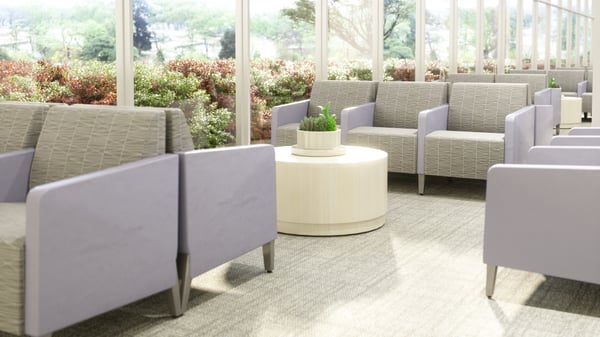Over the last 3 years, healthcare systems worldwide have undergone extreme changes brought on by tremendous pressure. They continue to be taxed and look toward the future as the world continues to recover from the pandemic. As hospitals and other healthcare facilities are taking the time to recover, they are also examining their design process and making changes to patient well-being through furniture design.
In 2023, the major healthcare furniture design trends that we are seeing are in direct response to the issues that arose during the pandemic. Manufacturers and contract furniture salespeople should keep the following issues in mind when planning layouts for clients in the healthcare vertical with The KITS collaborator. Proper healthcare furniture design can help clients manage issues such as overcrowding and space flexibility; staff comfort and retention; and the behavioral health of both caregivers and patients. These healthcare design trends are sometimes similar to the ones we’ve seen in education and business settings as well, showing consistent responses to the societal changes we’ve seen in the early 2020s.
4 Key Trends in Healthcare Furniture Design
Trend 1 – Focusing on Patient and Caregiver Wellness with Welcoming Environment
One of the major outcomes we’ve seen from the pandemic is the impact on mental health and wellness for many people. Increased social isolation; major changes to work habits; job closures and general anxiety all impacted people everywhere. The toll that the pandemic took on people’s mental health can still be felt to this day and so healthcare facilities are working to combat this impact.

While there has been an increase in mental health services for both patients and caregivers, there is also an effort underway to change the design of healthcare spaces to be more inviting and comforting to combat the unease many people feel in those spaces. Larger more comfortable furniture is being considered, to make the space feel more homelike. Building spaces with more natural daylight and surrounding nature is also becoming a priority. The main goal of this trend is to minimize the impact healthcare spaces can have on your senses since they are typically anxiety-inducing for many patients. By making both patients and caregivers more comfortable, it’s easier to focus on the main issue at hand: patient healing and recovery.
Trend 2 – Adaptivity is Crucial and Fundamental to Healthcare
Flexibility is a term we use often when we discuss a space that can change to meet the needs of its users and is a buzzword in contract furniture for offices, education and health. Healthcare spaces need to have the ability to be adaptable to be able to provide care to as many people as possible. Healthcare spaces need to go beyond being flexible to make sure they can serve their patients.
During the pandemic, the adaptivity of healthcare spaces was pushed to the limit. Many of us saw the stories of how ICUs were filled and the strain it took on the healthcare system. Spaces now have to be designed with these types of conditions in mind to try and make sure our healthcare systems are ready for this sort of surge in the future. This means when designers are looking at a space, they need to be looking at all the ways it can be used and choosing furniture and designs to maximize functionality in all settings. This means looking at things such as moveable walls to open or shrink spaces, or create physical distancing when needed and add privacy if a common area needs to be turned into a consultation room. Administration spaces should be ready to move, with multi-purpose storage and seating that can be moved closer together to create space elsewhere is key. And finally no healthcare furniture design trend would be complete without a look at easily cleaned and disinfected materials. By planning and thinking of the future, designers can set caregivers up for success and hopefully ease the strain.
Trend 3 – Doubling Down on Inclusivity and Accessibility
While most healthcare facilities are built with accessibility in mind, it often has a one-size-fits-all approach. While this approach can be functional, it is not optimal and can still have issues. While this may be a hard thing to change in facilities that cater to a large population, smaller facilities that cater to a smaller population or those with similar accessibility needs are starting to make changes to cater to their visitors. Facilities that are catering to seniors are using furniture that makes standing up easier. Bathrooms are being tailored to be more accessible and open for those with mobility issues. Inclusivity can also go into the sensory. More consideration is being taken with lighting, materials and sound proofing to make sure patients don’t get over stimulated and increase their anxiety.
.jpg?width=600&height=338&name=170451%20-%20View3%20(1).jpg)
Trend 4 – Telehealth, a Powerful Tool That is Here to Stay
As with many industries, healthcare came to rely on digital tools during the pandemic to ensure consistent care and coverage for their patients. Telehealth continues to be a powerful tool for caregivers to reach those who may not need in-person care and can minimize office visits for patients who may only have small non-urgent questions or issues. Telehealth is also a great way to connect those in more remote rural communities to healthcare professionals rather than forcing them to travel.

In terms of healthcare furniture design, telehealth has affected staff areas more than patient spaces in healthcare facilities. Like a business hybrid workspace, healthcare professionals need semi-private spaces where they can connect with patients virtually either on the phone or via video conferencing tools. This could mean creating more office spaces or finding smart solutions with the use of pods or other privacy-creating pieces of furniture to ensure they can focus on their patients without distraction.
Trend 5 - Lessons Learned for Infection Control
During the pandemic air system filtration and touchless tech became a mainstay in many healthcare spaces. However, sometimes these systems had to be brought into existing spaces that weren’t necessarily designed for them. Designers should now be sure to design spaces that can be able to accommodate these systems and be flexible should there be other breakouts or even to help slow the spread of seasonal illnesses.
Looking Forward
These healthcare furniture design trends are the ones that we are prominently seeing in proposals for new health spaces. Like the trends we’ve seen in education and business, these trends while brought in a time of crisis, seem to be here to stay. With proper planning and taking advantage of these trends, designers can set up healthcare facilities for success and ease the constant burden our healthcare systems carry.
Want to learn more about the current design trends we are seeing across other industries? Check out our trend breakdowns for both business and education. Want to learn more about how The KITS collaborator can help you plan healthcare spaces for your clients? Schedule a demo with us today.



